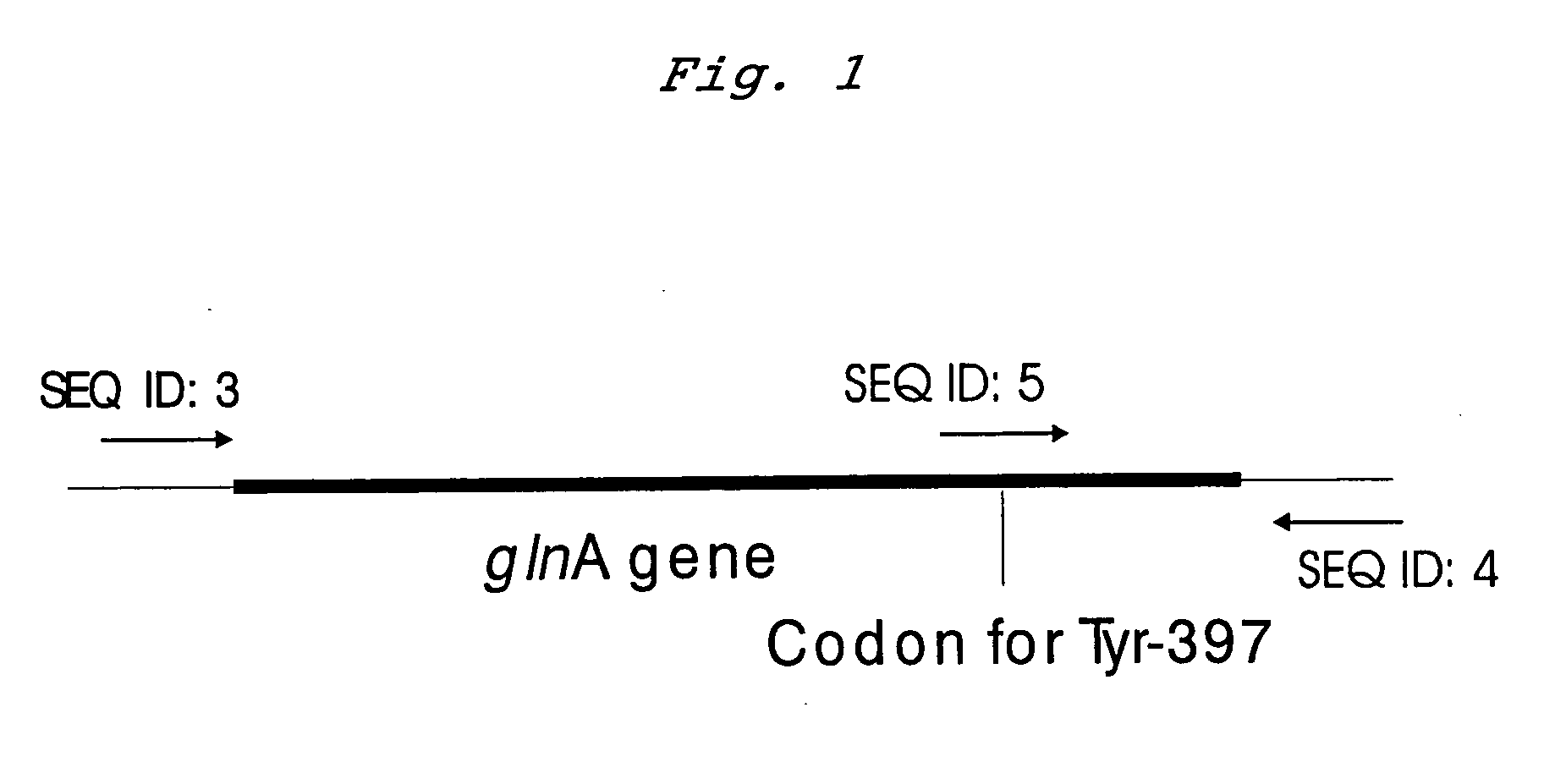Mutant glutamine synthetase and method for producing amino acids
a glutamine and amino acid technology, applied in the microbiological industry, can solve the problem of lack of reports of amino acid production using mutated gs without adenylylation ability
- Summary
- Abstract
- Description
- Claims
- Application Information
AI Technical Summary
Benefits of technology
Problems solved by technology
Method used
Image
Examples
example 1
[0045] The wild type glnA gene was obtained by amplification using PCR procedure and cloned into the vector pMW118 yielding the plasmid pMWglnA12. The chromosomal DNA of E. coli strain K12 was used as a template, oligonucleotides depicted in SEQ ID NO: 3 and 4 was used as primers. PCR procedure was carried out as follows: pretreatment at 94° C. for 5 min, then 40 cycles at 55° C. for 30 sec, 72° C. for 2 min, and 93° C. for 30 sec. Thus obtained PCR product was treated by XbaI and HindIII restrictases and ligated with the vector pMW118 plasmid previously treated with the same restrictases, yielding the plasmid pMWglnA12. To replace the TAT codon, encoding Tyr-397 in GS peptide, by the TTT codon, encoding phenylalanine, PCR procedure for site-directed mutagenesis was used. The pMWglnA12 plasmid carrying the wild type glnA gene was used as a template, oligonucleotides depicted in SEQ ID NO: 4 and 5 was used as primers. PCR procedure was carried out as foll...
example 2
Construction of an ilvA Deficient Derivative from the Wild Type Strain E. coil K12, having a Mutation in the ilvA Gene
[0046] The strain VL334 (VKPM B-1641) is an isoleucine auxotrophy and threonine auxotrophic strain, having mutations in thrC and ilva genes (U.S. Pat. No. 4,278,765). A wild type allele of thrC gene was transferred by the method of general transduction using bacteriophage P1, grown on cells of the wild type E. coli strain K12 (VKPM B-7). As a result, the isoleucine deficient strain VL334thrC was obtained.
[0047] Then, the plamid pMWglnAphe-4 was introduced into cells of the VL334thrC+ strain resulting the strain VL334thrC+ / pMWglnAphe-4. As a control, the plasmid pMWglnA12 was also introduced into cells of the strain VL334thrC+ yielding the strain VL334thrC+ / pMWglnA12.
example 3
Production of Glutamine and Glutamic Acid by the Strain Harboring the Mutant glnA Gene in Test-Tube Fermentation
[0048] The cultivation conditions in test-tube fermentation was as follows: the fermentation medium contained 60 g / l glucose, 35 g / l ammonia sulfate, 2 g / l KH2PO4, 1 g / l MgSO4, 0.1 mg / l thiamine, 50 mg / l L-isoleucine, 5 g / l yeast extract Difco, 25 g / l chalk (pH 7.2). Glucose and chalk were sterilized separately. 2 ml of the medium was placed into test-tubes, inoculated with one loop of the tested microorganisms, and the cultivation was carried out at 37° C. for 2 days with shaking. The amount of produced glutamic acid and glutamine were determined by TLC (isopropanol:ethylacetate:ammonia:water=16:8 5:10 (v / v)). The results are shown in Table 1.
TABLE 1Accumulation ofAccumulationglutamic acid,of glutamine,Straing / lg / lVL334thrC+12.00VL334thrC+ / pMWglnA127.50VL334thrC+ / pMWglnAphe-41.31.3
[0049] As is shown in the table 1, the strain VL334thrC+ / pMWglnAphe-4 carrying mutant gln...
PUM
| Property | Measurement | Unit |
|---|---|---|
| temperature | aaaaa | aaaaa |
| temperature | aaaaa | aaaaa |
| temperature | aaaaa | aaaaa |
Abstract
Description
Claims
Application Information
 Login to View More
Login to View More - R&D
- Intellectual Property
- Life Sciences
- Materials
- Tech Scout
- Unparalleled Data Quality
- Higher Quality Content
- 60% Fewer Hallucinations
Browse by: Latest US Patents, China's latest patents, Technical Efficacy Thesaurus, Application Domain, Technology Topic, Popular Technical Reports.
© 2025 PatSnap. All rights reserved.Legal|Privacy policy|Modern Slavery Act Transparency Statement|Sitemap|About US| Contact US: help@patsnap.com

